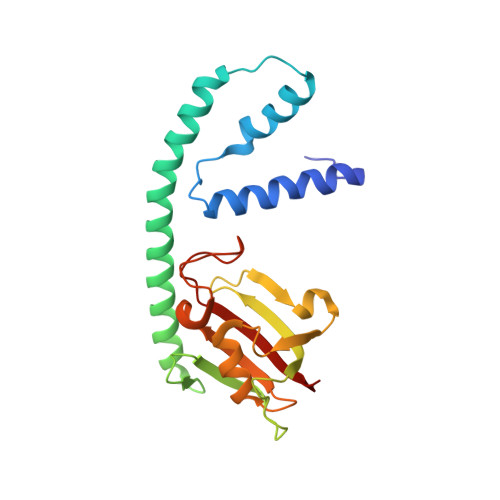Structural characterization of PaFkbA: A periplasmic chaperone from Pseudomonas aeruginosa .
Huang, Q., Yang, J., Li, C., Song, Y., Zhu, Y., Zhao, N., Mou, X., Tang, X., Luo, G., Tong, A., Sun, B., Tang, H., Li, H., Bai, L., Bao, R.(2021) Comput Struct Biotechnol J 19: 2460-2467
- PubMed: 34025936
- DOI: https://doi.org/10.1016/j.csbj.2021.04.045
- Primary Citation of Related Structures:
7DEK - PubMed Abstract:
Bacterial Mip-like FK506-binding proteins (FKBPs) mostly exhibit peptidyl-prolyl-cis/ trans -isomerase (PPIase) and chaperone activities. These activities are associated with various intracellular functions with diverse molecular mechanisms. Herein, we report the PA3262 gene-encoded crystal structure of the Pseudomonas aeruginosa PAO1's Mip-like protein PaFkbA. Biochemical characterization of PaFkbA demonstrated PaFkbA's chaperone activity for periplasmic protein MucD, a negative regulator of alginate biosynthesis. Furthermore, structural analysis of PaFkbA was used to describe the key features of PaFkbA chaperone activity. The outcomes of this analysis showed that the hinge region in the connecting helix of PaFbkA leads to the crucial conformational state transition for PaFkbA activity. Besides, the N-terminal domains participated in dimerization, and revealed its potential connection with FKBP domain and substrate binding. Mutagenesis and chaperone activity assay supported the theory that inter-domain motions are essential for PaFkbA function. These results provide biochemical and structural insights into the mechanism for FKBP's chaperone activity and establish a plausible correlation between PaFkbA and P. aeruginosa MucD.
Organizational Affiliation:
Center of Infectious Diseases, State Key Laboratory of Biotherapy, West China Hospital, Sichuan University and Collaborative Innovation Center, Chengdu, China.














